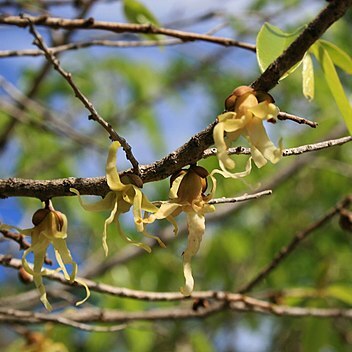A shrub or tree which loses its leaves during the year. In tropical regions it grows 12 m tall. It is shorter in cooler regions. The young branches are covered with brown hairs. The leaves are oval and 4-10 cm long. They are carried one after the other on opposite sides of the stalk and have short stalks. The flower buds grow in the axils of leaves. These buds are fat, golden brown and velvety and remain after the leaves fall. These develop into pale yellow almost stalkless flowers. The flower petals are narrow and very crinkled. The fruit are 5 cm long and 2.5 cm wide. They are oblong with irregular bulges. They are scarlet with a netted appearance and have green veins. The flesh is dark red when ripe. They are juicy and edible.
Leaves petiolate; lamina 3–10 (15) x 1.5–5 (6) cm., elliptic-oblong to obovate, obtuse to rounded or emarginate at the apex, cuneate to rounded or subcordate at the base, chartaceous or subcoriaceous, concolorous, ± glabrescent above and often also below, but persistently appressed-pubescent or tomentellous along the midrib below, with arcuate-ascending nerves slightly prominent on both sides or only below and reticulate venation usually prominent only above; petiole 1–4 (8) mm. long, pubescent.
Fruit subsessile; fruiting carpels 1–3 (4), several-seeded, 2–3.5 x 1–1.5 cm., cylindric-ellipsoid to obovoid, not apiculate, sometimes constricted between the seeds, sparsely brown-puberulous, finely rugose, scarlet, sessile.
Flowers solitary, axillary, subsessile, opening after leaf-fall; bracteoles 2–3, elliptic-orbicular, cucullate, densely brown-appressed-pubescent outside, glabrous and rugose within, the inner pair enclosing the bud, caducous.
Petals yellow or cream, thin, subequal, the inner whorl narrower, 10–20 mm. long, narrowly lanceolate, corrugated, obtuse, brown-sericeous outside near the base, appressed-puberulous towards the apex and within.
Sepals 4–6 mm. long, ovate-elliptic, acute or obtuse, cucullate, brown-sericeo-pilose outside, glabrous and rugose within, spreading widely at anthesis.
Branches spreading, ± densely brownish-pubescent or-tomentellous at first, eventually glabrous, with ± prominent and persistent petiole-bases.
Stamens 1–1.5 mm. long, linear or obconic, glabrous; connective-appendage capitate.
Shrub or tree, sometimes much branched but not climbing, 2–7 (9) m. high.
Seeds 1.2–1.5 x 0.6–0.7 cm., semi-lunar, triquetrous.
Carpels 4–6, densely pubescent.

